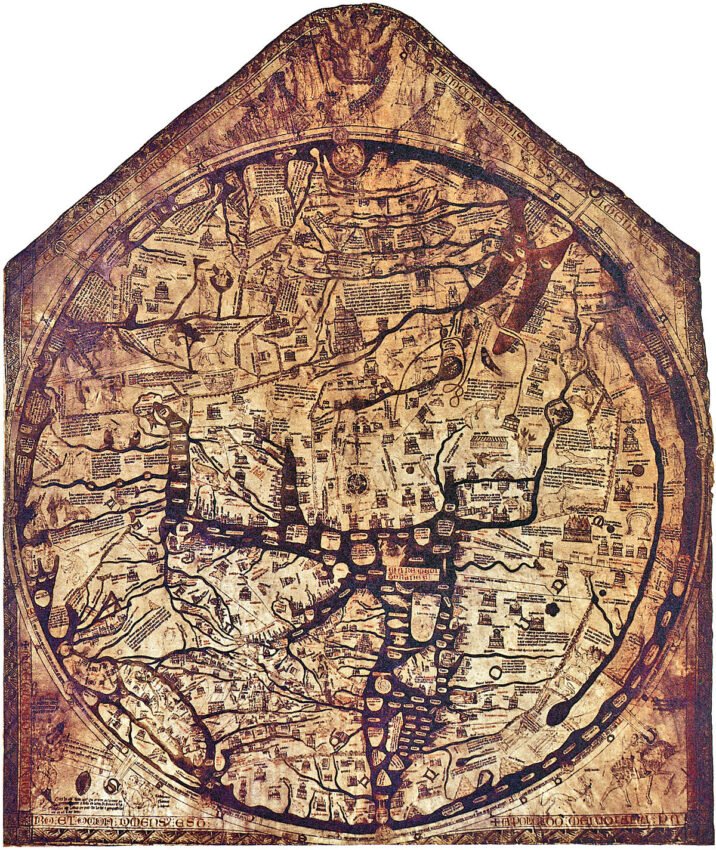History students share their experiences studying a map of the medieval world.

On March 14th, 2024, two history courses hosted an event at the Murray Library that displayed USask Special Collections’ incredible array of medieval manuscripts and documents, including a map of the world that dates to the year 1300. The event, entitled “Medieval Wonders: Maps, Manuscripts, and Beasts,” was organized by Dr. Sharon Wright and Dr. Frank Klaassen of the history department and included presentations on the documents from their students.
During the event, Wright gave a presentation on the highlighted piece from USask’s medieval collection: a facsimile of the Mappa Mundi, the largest medieval map of the world (measuring 1.59 x 1.34 metres). The original map is currently stored at the Hereford Cathedral. It was created in England around the year 1300, and is described on the Hereford Cathedral’s website as showing “the history, geography and destiny of humanity as it was understood in Christian Europe in the late thirteenth and early fourteenth centuries.”
When Wright heard that the map was coming to USask Special Collections in January 2024, she became very excited about the opportunity to do a project on the map with students. Throughout the Winter 2024 semester, Wright and her students in the seminar course History 411, “Topics in Medieval History 1000-1500,” have been studying the Mappa Mundi very closely.
The students in History 411 have each chosen one subject on the map to research, and they presented their findings on the significance of these features during the Medieval Wonders event and answered the public’s questions about them. The students prepared for the event much in the same way they would conduct research for an essay, looking into the background and significance of the depictions on the map.
“There’s a chaos to it that our minds just have fun putting together,” said Brett Schatz, a student in History 411 who has been working with the Mappa Mundi throughout the semester. “It sparks the imagination.”
Warsha Mushtaq, a second-year History major who is also taking History 411, shared that the map is “like a celebration of shared history,” with many different layers and meanings to pick apart and relate to our world today.
The Mappa Mundi and its illustrations show a unique blend of history, biblical stories, mythology and more.
“It speaks to the continuity of the human experience,” said Pascale Yee, a student in History 411. “I think that regardless of your area of expertise in history, there’s something that we can all relate to when you study any time or period.”
Some of the topics that the History 411 students chose to focus on included cities such as Constantinople, Jerusalem and Paris, the Virgin Mary, the Tower of Babel, marine life of real and mythological nature and plants with various medicinal and magical properties – all of which are illustrated across the map. In choosing these projects, the students often sought to pursue their own historical interests and learn more about how they were understood in the medieval world.
In addition to the presentations from History 411, this event included presentations from students in a course taught by Dr. Klaassen: Classical, Medieval and Renaissance Studies 333, “Exploring Medieval and Early Modern Manuscripts.” These students displayed their own research on various other manuscripts and documents within the medieval collection at the university archives. The event was a great success, exceeding the room’s capacity with 60 attendees.
“I was very proud of the community coming out,” said Jake Graham, another History 411 student. Mushtaq was excited that this type of public history, especially when incorporating the digital humanities, can help to bridge some gaps and reach more people outside of academia.
Other students in History 411 encouraged others to check out the archival collection and the unique opportunities afforded by courses like this one.
“As someone who grew up in a very, very small town in Saskatchewan, it was hard to imagine this kind of stuff being accessible here in Saskatchewan,” said Ray Morstad, a recent graduate of the history department who is currently pursuing a Master’s in Library and Information Science. “I don’t think there was ever a time where I even considered studying medieval history until I took my first medieval history class here. It just opened up this fantastic world to me of information and magic, and in such powerful imagery and narratives.”
History 411 is a general shell course, with the topic of focus changing each time it is offered based on the instructor and year. Wright will be teaching the course again next year, and it will be focusing on Medieval Law and Crime.
Morstad also said he enjoys classes like History 411 because you get the unique chance to work with people of different historical backgrounds. Lennon Brown – another student – agreed, adding that “a good selling point for a class like this is that it’s a small group of people, and you get to know each other and share ideas.”
Wright said that she was very proud of this class and the work they have done, including the public-facing work of the event. She enjoyed hearing all of her students’ different ideas in class, and shared that even though the map was the focus, they covered a wide variety of readings that made the course quite interdisciplinary.
“I’ve asked a tremendous amount from them and they’ve really come through, and it was great to see the work that they did,” said Wright.
For those interested in learning more about these documents and this riveting chapter of our history, the facsimile of the Mappa Mundi and other manuscripts from the medieval world are available through the USask Archives and Special Collections. More information about the collections and how to set up an appointment to visit the archives can be found on their website.